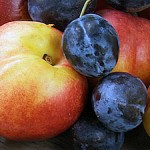Description
This recipe has no measurements so lets you use up the end-of-the-season plums. Because plums have a lot of natural pectin, there’s no reason to add commercial pectin. Just let the plums and sugar cook away.
Ingredients
- Wild plums, rinsed and stemmed [Note: I used regular plums]
- Sugar
- Lavender flowers
- Fresh lemon juice (optional)
Instructions
- In a very large pot, place as many plums as the pot can manage with 1/2 inch (at most) of water at the bottom. Cook over low to medium heat, stirring on occasion, until the fruit is very soft and pulpy, about 45 minutes. Cool slightly, and then strain the mixture in a large cone sieve placed over a second pot, pressing hard on the solids to extract the pulp and juices. Discard the remaining solids and pits.
- Measure the pulp. For every cup, you will want to add a scant 3/4 cup sugar, perhaps a little less or more depending on how sweet you like your jam. You can start with less, and add more as desired later. Or simply eyeball it with as much sugar as you think it will need, a method my sister Sara uses quite regularly with great success. Add a small handful of lavender flowers. (Simply pick unsprayed lavender stems and leave them out in the sun for a few days, then pull off the flowers when dried. Fresh lavender flowers will work too, but dried seems to offer more concentrated flavours.)
- Once you’ve added the sugar and lavender, bring the mixture to a simmer over low to medium heat, gently stirring to dissolve the sugar. When dissolved, raise the temperature a smidge, then cook at a fairly rapid simmer, stirring on occasion, for 30 to 40 minutes, until desired setting point is reached. To check the set, place a spoonful on a cold plate and let sit for 1 minute. Then run your finer through it; it should wrinkle and feel firm.
- More often than not, I allow the jam pot to sit on the stove for a day (or longer) after it has cooked once, allowing the flavours to develop. Then I add more sugar to taste, or a squeeze of lemon juice, if needed, and cook again. At this point, watch it more closely so it doesn’t burn — or turn a deep, rosy amber color (at which point you will have more of a plum butter –yummy too). Pot the jam in sterlized jars, top with hot lids and bands, and turn the jars over for 1 hour to help complete the seal.* Store in a dark cupboard for up to a year, or longer in the refrigerator.
Notes
Before you write impassioned letters warning me of the dangers of improperly sealed food, I hereby endorse sealing jams and preserves in a boiling water bath for 10 to 15 minutes. Whether you follow Steel’s directions or mine, be sure your lids “pop” so you know you have a true seal. For those unfamiliar with the method, here’s a link to Bernardin’s instructions.
Excerpt from Plum Gorgeous by Romney Steel. Published by Andrews McMeel © 2011.
